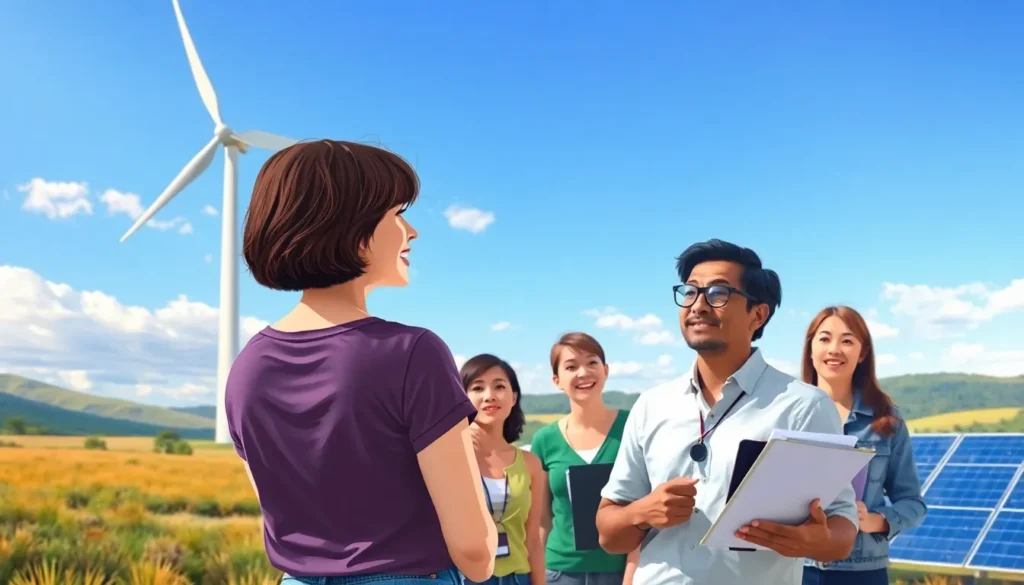Table of Contents
ToggleIn a world buzzing with innovation, energy technology news is the spark that ignites curiosity and drives change. From solar panels that double as art to wind turbines that could practically dance, the advancements in energy tech are nothing short of electrifying. It’s not just about keeping the lights on anymore; it’s about how to do it smarter, cleaner, and with a dash of flair.
Imagine a future where your coffee maker knows when to brew based on the sun’s rays or where your car charges itself while you binge-watch your favorite show. Sounds like sci-fi? Well, it’s happening now! Stay tuned as we dive into the latest breakthroughs that are transforming our energy landscape, making it more sustainable and, dare we say, a bit more fun.
Recent Developments in Energy Technology
Recent advancements in energy technology drive the transition to more sustainable solutions. Innovations continually emerge, transforming energy consumption methods and promoting cleaner alternatives.
Breakthroughs in Renewable Energy
Innovative solar panel designs have surfaced, blending aesthetics with functionality. Artists and engineers collaborate to create visually appealing solar installations that attract attention while generating power. Wind turbines have also evolved; dynamic models now adapt to varying weather conditions, improving energy efficiency. Hydropower techniques have advanced, incorporating smaller-scale, smarter systems that harness energy from flowing water with minimal environmental impact. These breakthroughs highlight the ongoing shift towards a diversified energy landscape that enhances overall sustainability.
Innovations in Energy Storage
Modern energy storage systems feature significant developments that optimize electricity use. Battery technologies have improved, offering higher capacities and faster charging times, making electric vehicles more practical. Solid-state batteries are gaining traction for their safety and efficiency, promising superior performance over traditional lithium-ion options. Energy management systems integrate artificial intelligence to optimize storage distribution, ensuring energy is available when needed. Advances in pumped hydro storage techniques further boost flexibility by storing excess energy efficiently. These innovations position energy storage as a crucial component in achieving a sustainable energy future.
Government Policies Impacting Energy Technology

Government policies play a crucial role in shaping the landscape of energy technology. By offering incentives and implementing regulations, these policies significantly influence the progress of cleaner energy solutions.
Incentives for Clean Energy
Financial incentives encourage investment in renewable technologies. Tax credits, including the Investment Tax Credit (ITC) and Production Tax Credit (PTC), enhance the attractiveness of solar and wind projects. Grants and subsidies also support research and development in energy-efficient technologies. Moreover, loan programs available for clean energy projects help reduce upfront costs. States like California and New York actively promote community solar programs, allowing residents to invest in solar energy collectively. The combined effect of these incentives can lead to increased adoption of sustainable energy technologies nationwide.
Regulations on Traditional Energy Sources
Regulations limit the environmental impact of traditional energy sources. Governments enforce emission standards targeting fossil fuels, compelling companies to reduce pollutants. Recent policies have led to the gradual phase-out of coal plants in favor of cleaner energy sources. In some regions, stricter safety regulations apply to oil and gas drilling, ensuring responsible extraction practices. Additionally, authorities implement renewable portfolio standards, requiring utilities to incorporate a specified portion of renewable energy in their mix. Through these regulations, governments steer the energy sector towards a cleaner and more sustainable future.
Key Players in the Energy Technology Sector
The energy technology sector features various influential companies and research institutions driving innovation for a sustainable future.
Leading Companies and Startups
Tesla focuses on creating advanced battery technology and solar energy systems. NextEra Energy leads in renewable energy production, capitalizing on wind and solar resources. Bloom Energy specializes in clean fuel cell technology to provide reliable energy solutions. Startups like Nextracker and Energy Vault contribute with solar tracking systems and gravity-based energy storage, respectively. Significant investments from these entities enhance the development of next-generation energy solutions.
Research and Development Institutions
National Renewable Energy Laboratory (NREL) pioneers research on renewable energy technologies and energy efficiency. Massachusetts Institute of Technology (MIT) conducts groundbreaking studies in energy systems and innovative materials. Additionally, Stanford University focuses on sustainable energy initiatives, exploring options like advanced photovoltaic materials. Research institutions globally, including Fraunhofer Institute for Solar Energy Systems, advance energy technologies through collaborative efforts, fostering an ecosystem of technological innovation and sustainability.
Global Trends in Energy Technology
Innovations in energy technology are driving a shift towards more sustainable practices worldwide. Developments in renewable energy and smart solutions lead this transformation.
The Shift Toward Sustainability
Increased adoption of clean energy sources shapes the global energy landscape. Solar panels become more aesthetically pleasing, attracting interest from homeowners. Wind turbine efficiency improves with adaptive designs, allowing for better energy capture. Countries pursue ambitious goals to cut carbon emissions, aligning policies with sustainability objectives. A focus on smaller-scale hydropower systems minimizes environmental disruptions while maximizing power generation. These trends indicate a steadfast commitment to a greener future.
Advances in Smart Grid Technology
Smart grid technology enhances energy distribution efficiency, optimizing supply and demand. Research highlights advanced metering infrastructure facilitating real-time data communication. Utilities benefit from improved management and monitoring of energy flows. Innovative software integrates artificial intelligence, predicting energy consumption patterns. Enhanced cybersecurity measures safeguard critical infrastructure. Moreover, distributed energy resources, like home solar installations, contribute to grid resilience. The rise of electric vehicles further influences grid operations by providing storage potential during off-peak hours.
The energy technology landscape is evolving rapidly with innovations that promise a more sustainable future. As advancements in renewable energy and smart grid technology gain traction, the potential for cleaner energy solutions becomes increasingly evident. The commitment from key players and supportive government policies further accelerates this transition.
With a focus on efficiency and environmental impact, the sector is poised for significant growth. The integration of AI and improved storage solutions will enhance energy management and distribution. As these technologies continue to develop, they’ll shape not only the energy industry but also everyday life, making sustainable energy a core aspect of modern living.







